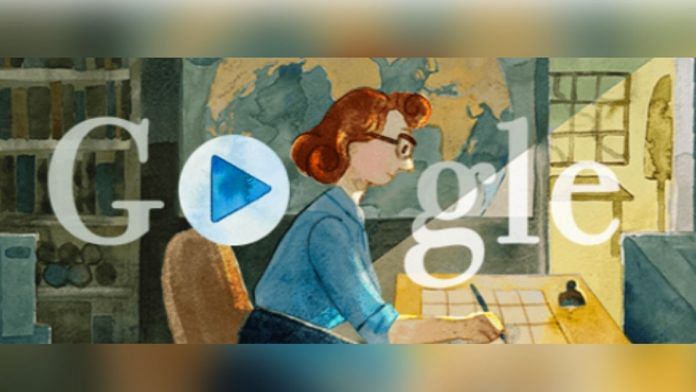New Delhi: Google Monday celebrated the life of American geologist and oceanographic cartographer Marie Tharp with an interactive doodle on its homepage.
On this day in 1998, the US Library of Congress declared Tharp as one of the greatest cartographers of the 20th century. She is known for her work in revealing the topography of ocean floors. In 1957, Tharp and geologist Bruce Heezen co-published the first map of the ocean floor in the North Atlantic.
The Google Doodle, with voice over by Caitlyn Larsen, Rebecca Nesel and Tiara Moore, takes users through several illustrations chronicling Tharp’s life and career.
Born on 30 July 1920, in Ypsilanti, US, her father, William Edgar Tharp, was a soil surveyor for the United States Department of Agriculture.
Tharp initially completed a bachelor’s degree in English and music from the Ohio University in 1943. But she soon discovered her love for geology and went on to complete her master’s degree in the subject from the University of Michigan the following year.
In 1948, she moved to New York City and became the first woman to work at the Lamont Geological Observatory where she met Heezen.
Tharp and Heezen worked together for 25 years, where they processed thousands of unexamined sounding records of the North Atlantic Ocean floor. Using temperature readings, salinity measurements, and cores, they revealed, for the first time, a rift valley trending down the center of the Mid-Atlantic ridge.
The duo published their first map of the Atlantic Ocean in 1957, which revealed that the seafloor is covered with canyons, ridges, and mountains.
Two decades later, in 1977, National Geographic published the first complete map of the ocean floors created by Tharp and Heezen that helped prove the theory of plate tectonics and the concept of continental drift.
Battling bias
As a woman scientist in the 20th century, Tharp had to battle bias throughout her career. Her observations had been dismissed as “girl talk” and she was not allowed to board ships collecting seafloor data until 1968.
Like many other women scientists during the era, Tharp’s contributions were also recognised much later.
In 1995, she donated her entire map collection to the Library of Congress. She was honoured by the Library of Congress on the 100th anniversary of its geography and map division in 1997. A fellowship at the Lamont–Doherty Earth Observatory, the scientific research center of the Columbia Climate School, now provides a fellowship under her name to promote women in science.
Tharp died of cancer in 2006 at the age of 86 in Nyack, New York.
Also read: Ronna, quetta, ronto & quecto: As measurements get new prefixes, Earth now weighs 6 ronnagrams






